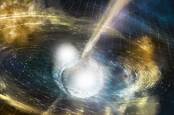This article is more than 1 year old
Holy macaroni! After months of number-crunching, behold the strongest material in the universe: Nuclear pasta
Probably cost a pretty PENNE to run that physics simulation
Good luck sinking your teeth into nuclear pasta. For one it’ll be tricky to get a hold of since it’s the stuff lodged inside neutron stars. Additionally, it may also be the universe’s strongest material.
Neutron stars are the cores leftover from dead stars that have already shed their gaseous layers in a supernova explosion. All the mass remaining – normally greater than one solar mass – is squeezed into a tiny radius on the order of 10 kilometres (6.2 miles), making them the densest objects in the known universe.
The strong gravitational pressure compresses the neutron star's crust, keeping it solid. Below this layer, the competing forces between protons and neutrons cause the particles to arrange themselves into strange formations. Sometimes they will organize into flat planes like lasagna or long cylinders like spaghetti, giving them the very scientific name of nuclear pasta.
Scientists believe that nuclear pasta may be the strongest material in the universe due to its extremely high densities and unique structures. The academics performed intensive computer simulations to model the interactions between millions of protons and neutrons to estimate the pasta's shear modulus is about 1030 ergs per cm3, and has a breaking strain greater than 0.1.
To put that in perspective, diamond on Earth typically has a shear modulus of 4.78×1012 ergs per cm3 – and the higher the number, the stronger the stuff. So nuclear pasta is in another league compared to our planet's materials. It's like comparing parsecs to kilometres.
Processing time
The simulations were computationally intensive, and required a whopping two million hours worth of processor time, or the equivalent of 250 years on a laptop with a decent GPU. In reality, hundreds of processors on a supercomputer crunched numbers in parallel to complete the calculation in a year or two, Matthew Caplan, first author of the research paper and a postdoctoral fellow in theoretical astrophysics at McGill University, told The Register.
“The simulation takes a long time for a few reasons," he said. "First, with 983,040 protons and 2,293,760 neutrons, there are a lot of forces to calculate. For example, every proton is repelling every other proton electromagnetically, which means our code has to calculate the forces between all of them,” he added.
“That requires a lot of math. To simulate them, we have to do this calculation over and over again. The simulation 'updates' by moving the protons and neutrons a very small distance, and recalculates the forces to figure out where to move them next. Our supercomputer did this over 16 million times.”
Liquid pasta
Nuclear pasta may be reality's strongest material, but it’s actually a liquid crystal with properties similar to solids and liquids. It’s like a solid crystal because it has a regular structure and order, with sheets of lasagna lying on top of one another. But it’s also like liquid because the particles within it can move around almost freely and flow. So nuclear pasta can be rearranged if you squeeze it hard enough.
The results are purely estimations gathered from simulations, however there may be ways to test them experimentally.
“While we can't make nuclear pasta in a lab on earth, we can study analog systems. Lots of polymers and liquid crystals have phases like nuclear pasta, they just have more serious sounding names!” Caplan explained to El Reg.
"One famous example are biological membranes in living cells. We've actually studied how the nuclear pasta lasagna exhibits the same structure and structural defects as the endoplasmic reticulum. Often times in science you can learn things about one system by studying another analog system with similar properties."
The paper has been accepted by Physical Review Letters. It may help scientists understand the gravitational waves emitted when two neutron stars collide, and if lone neutron stars produce gravitational waves, too.
“A lot of interesting physics is going on here under extreme conditions and so understanding the physical properties of a neutron star is a way for scientists to test their theories and models, Caplan concluded on Tuesday.
“With this result, many problems need to be revisited. How large a mountain can you build on a neutron star before the crust breaks and it collapses? What will it look like? And most importantly, how can astronomers observe it?” ®

